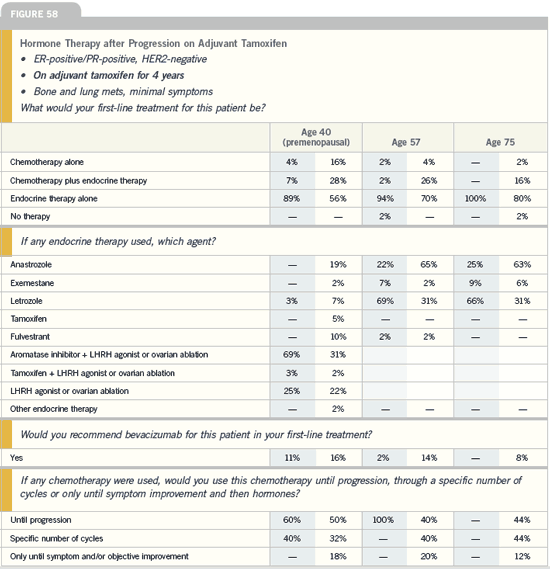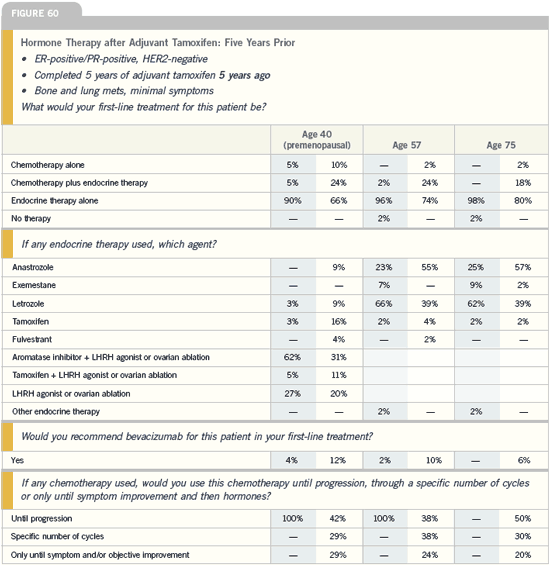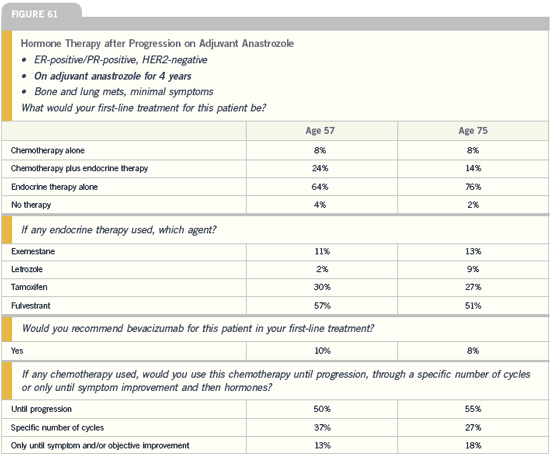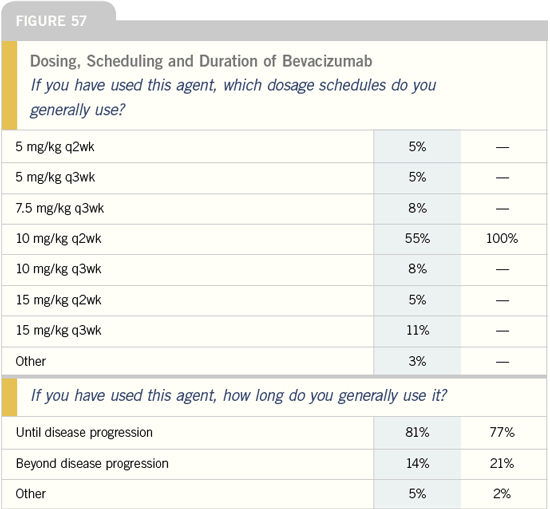| |
Endocrine Therapy for Metastatic Disease |


Optimal sequencing of agents
in postmenopausal patients
| Breast Cancer Update 2005 (4) |
DR GRADISHAR: If you evaluate most of
the available data with endocrine agents
in the metastatic setting — tamoxifen,
steroidal or nonsteroidal aromatase
inhibitors or fulvestrant — the question
that comes up is whether one sequence
enhances patient outcome more than
another. This becomes important because if you can demonstrate that one
sequence enhances the time to disease
progression, it may be built on over time
so that overall outcome is improved. In
theory, simply having an improvement in
recurrence or progression of metastatic
disease impacts quality of life.
Patients now typically receive a
nonsteroidal aromatase inhibitor —
anastrozole or letrozole — as the first
treatment. The question then becomes, if
patients progress on one of those agents,
what would be the next best therapy?
Should it be the steroidal aromatase
inhibitor exemestane, or should it be
fulvestrant? Indirect data evaluating the
sequence of a nonsteroidal aromatase
inhibitor to fulvestrant suggest that 25 to
30 percent of patients may benefit with
that approach.
An important issue is whether
fulvestrant 250 mg is optimal. Some of
the data suggest that the dose is really on
the low end of the curve where you might expect the optimal response rate. Some
strategies have evaluated quickly increasing
serum levels of fulvestrant, including
administering loading doses of 500 mg
and within two weeks administering
another 250 mg and then proceeding to
the monthly schedule.
Those strategies are based on mathematical
modeling that has shown an
ability to achieve steady-state levels much
more quickly and consequently achieve a
biologically relevant dose of drug circulating
much faster.


| Breast Cancer Update 2005 (9) |
DR GABRIEL N HORTOBAGYI: Assuming
an aromatase inhibitor and fulvestrant
are equivalent in efficacy, the choice of
which agent to use may come down to
patient preference. Some of my patients
are perfectly happy with a monthly
injection, while others prefer an oral
agent. For many patients, fulvestrant
is financially favorable because of our arcane reimbursement system. We know
that responses can be seen with either
sequence — an aromatase inhibitor
followed by fulvestrant or the opposite
— but I believe it’s important that we
determine which is superior.
I believe the trials of fulvestrant
underestimate the efficacy of this agent.
The dosing schedule used was probably
too low because by the time steady state
was reached, many patients were off
study, presumably because of progression.
In my group, we administer loading
doses of 500 mg of fulvestrant followed
by 500 mg two weeks later and then 250
mg monthly. The pharmacokinetics of
fulvestrant suggest a loading dose would
be beneficial, so it concerns me that the
comparison of fulvestrant to anastrozole
in a tamoxifen-resistant population
might not have revealed the true efficacy
of fulvestrant. It showed fulvestrant to be
at least as effective as anastrozole, but I
expected it to be superior. We may need
to repeat some of these studies with a
more appropriate dosing schedule.

| Breast Cancer Update 2005 (7) |
DR ADAM M BRUFSKY: Most clinicians
consider fulvestrant a third-line
therapy for patients who have failed
tamoxifen and an aromatase inhibitor;
however, clinical trials have shown that
fulvestrant is equivalent to anastrozole
after tamoxifen failure and, in a recently
published European study comparing
front-line fulvestrant to tamoxifen,
I did not view fulvestrant as inferior to
tamoxifen.
I use third-line fulvestrant, but I also
use it first line, particularly in women
who can’t afford an aromatase inhibitor.
In addition, I would estimate that
approximately 40 percent of my patients
prefer a monthly injection to taking a pill
every day.
| Meet The Professors 2004 (2) |
DR GERSHON LOCKER: The overall
results of Trials 20 and 21 showed
no significant difference between
anastrozole and fulvestrant, but differences
occurred in subset analyses.
The duration of response seemed to be longer in patients who responded to
fulvestrant, and patients who had visceral
disease seemed to respond better than
those who did not.
I think the takeaway message is that
they’re equally efficacious; however, there
may be subsets of patients in whom you
might prefer to use fulvestrant, particularly
those for whom compliance may be
an issue or those with visceral disease.
The other important point is that
anecdotal studies argue that you can use
one and switch to the other. Third-line
aromatase inhibitors are efficacious after
fulvestrant and vice versa.

| Patterns of Care 2005 (1) |
DR STEPHEN E JONES: Generally,
patients are either going to relapse on
tamoxifen or after adjuvant tamoxifen.
In that setting as well as in the fulvestrant
versus anastrozole clinical trials,
evidence exists that a proportion
of women have a longer response to
fulvestrant than to anastrozole when
given right after tamoxifen.
I‘ve had patients with long responses
to fulvestrant. I prefer fulvestrant to
an aromatase inhibitor after tamoxifen
because approximately 20 percent of patients have long responses with it in
this setting. However, 99 percent of
oncologists will choose an aromatase
inhibitor after tamoxifen. Fulvestrant
is generally being used as third line.
Despite Trials 20 and 21, most physicians
start with anastrozole rather than
fulvestrant because of the way the data
have been presented.
We are just beginning to see patients
who have been treated with two or three
years of adjuvant anastrozole and then
relapsed. Currently, there is little data
on treatment options in this setting. It’s
somewhat of a “dealer’s choice” because
there are no hard-and-fast rules. There are
multiple options including fulvestrant,
exemestane and even tamoxifen — if the
patient hasn’t seen it — because it’s obviously
still a useful drug. So the sequence
is going to be all over the map for most
folks.


| Breast Cancer Update 2005 (5) |
DR TRIPATHY: In the up-front study,
tamoxifen and fulvestrant were essentially
equivalent. As second-line therapy,
fulvestrant seemed to perform equally as
well as anastrozole. At this point in time,
the sequencing and timing for fulvestrant
are unclear. I think it’s reasonable to use
the drug — maybe not up front, but as
second- or third-line therapy.
This is when you might consider
the patient’s preferences in terms of an
intramuscular or an oral drug. A recent
study of 261 women with metastatic
breast cancer demonstrated that about
one third preferred a monthly intramuscular
injection. I’ve always assumed
that oral drugs were preferable, if they
were equally effective. Therefore, I was
surprised to see that many patients preferred
an intramuscular injection. I need
to query my patients more when I start
evaluating these options.
| Patterns of Care 2005 (1) |
DR HAROLD J BURSTEIN: Previously,
patients received tamoxifen in the
adjuvant setting, so we would use an
aromatase inhibitor front line in the
metastatic setting. Fulvestrant was used
second line, or we could use megestrol
acetate, but for many women fulvestrant
has a more convenient side-effect profile.
Now that more women receive aromatase
inhibitors in the adjuvant setting, we’re
using tamoxifen or fulvestrant as firstline
treatment in the metastatic setting.
| Patterns of Care 2005 (1) |
DR BLUM: In my experience, patients tolerate the fulvestrant injections just
fine. We have randomized data comparing
fulvestrant versus anastrozole
in patients who have already received
tamoxifen, but the optimal sequence for
using fulvestrant is still undetermined. In
choosing between an aromatase inhibitor
and fulvestrant, I ask my patients
whether they prefer an injection or a pill.
If they have transportation problems,
then I use an oral agent. However, for
the Medicare population, these drugs
are very expensive. If the patient does
not have adequate insurance coverage
and can’t afford them, a monthly injection
may be better. Compliance is also
an issue to be considered when choosing
between a daily oral agent and a monthly
injection.
| Breast Cancer Update 2004 (6) |
DR DANIEL F HAYES: I use fulvestrant
as third-line therapy in patients whose
disease has progressed on tamoxifen
and an aromatase inhibitor. That’s
the current indication, but it wouldn’t
surprise me to see it moved up because
data from the randomized trials clearly
suggest it is as effective as aromatase
inhibitors in patients who progressed
after tamoxifen. The clinical question is
whether the patient prefers a pill versus
parenteral injection. For some patients,
the injection is easier, but most patients
prefer taking a pill. In my experience,
the tolerability of fulvestrant is similar to
that of the aromatase inhibitors.
EFECT trial
| Breast Cancer Update 2004 (6) |
DR MITCHELL DOWSETT: EFECT
is an American and European study
that randomly assigns patients who
have failed therapy with a nonsteroidal
aromatase inhibitor to fulvestrant or
exemestane. Our own study, SoFEA, is
slightly different from EFECT because
it is based on the observation that the
addition of small amounts of estrogen to
cells that have been estrogen deprived for
a long time reduces the effectiveness of
fulvestrant. That scenario equates to the
withdrawal of a nonsteroidal aromatase
inhibitor and the addition of fulvestrant.
Hence, the third arm of our trial includes
a nonsteroidal aromatase inhibitor and
fulvestrant. I predict fulvestrant alone
will probably be better than exemestane,
and fulvestrant plus anastrozole will be
better than fulvestrant alone.
Select publications
|

